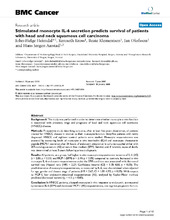Stimulated monocyte IL-6 secretion predicts survival of patients with head and neck squamous cell carcinoma
Peer reviewed, Journal article
Permanent lenke
https://hdl.handle.net/1956/2690Utgivelsesdato
2008-01-30Metadata
Vis full innførselSamlinger
Originalversjon
https://doi.org/10.1186/1471-2407-8-34Sammendrag
Background This study was performed in order to determine whether monocyte in vitro function is associated with presence, stage and prognosis of head and neck squamous cell carcinoma (HNSCC) disease. Methods Prospective study describing outcome, after at least five years observation, of patients treated for HNSCC disease in relation to their monocyte function. Sixty-five patients with newly diagnosed HNSCC and eighteen control patients were studied. Monocyte responsiveness was assessed by measuring levels of monocyte in vitro interleukin (IL)-6 and monocyte chemotactic peptide (MCP)-1 secretion after 24 hours of endotoxin stimulation in cultures supplied either with 20% autologous serum (AS) or serum free medium (SFM). Survival, and if relevant, cause of death, was determined at least 5 years following primary diagnosis. Results All patients, as a group, had higher in vitro monocyte responsiveness in terms of IL-6 (AS) (t = 2.03; p < 0.05) and MCP-1 (SFM) (t = 2.49; p < 0.05) compared to controls. Increased in vitro monocyte IL-6 endotoxin responsiveness under the SFM condition was associated with decreased survival rate (Hazard ratio (HR) = 2.27; Confidence interval (CI) = 1.05–4.88; p < 0.05). The predictive value of monocyte responsiveness, as measured by IL-6, was also retained when adjusted for age, gender and disease stage of patients (HR = 2.67; CI = 1.03–6.92; p < 0.05). With respect to MCP-1, low endotoxin-stimulated responsiveness (AS), analysed by Kaplan-Meier method, predicted decreased survival (χ = 4.0; p < 0.05). Conclusion In HNSCC patients, changed monocyte in vitro response to endotoxin, as measured by increased IL-6 (SFM) and decreased MCP-1 (AS) responsiveness, are negative prognostic factors.
